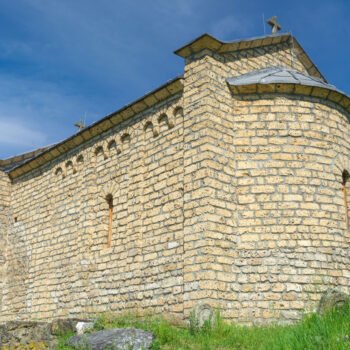- /
- Katun Road Pešter Pastures
- /
- Sacral Objects
Sacral Objects
Religious objects, mosques and churches, were also important as the places for education, the first libraries were built inside, they had the first calligraphers and the first rewriters of the old manuscripts. We would like to present two most important sacral object in this area, but you are welcome to explore the others too, the locals would gladly help you.
A Mosque in Petnjica
Petnjica Mosque, a cultural treasure in its own right, keeps the largest collection of rugs in Montenegro. Hundreds of Bihor rugs cover the ground and two other floors of this unusual mosque. In fact, this is the only three-stories mosque in Montenegro.
It is one of the largest mosques in the Balkans, of unique architecture, with wooden, hand carved pillars. It can accommodate up to 1,200 believers.
It is not known for certain when it was built. It is believed that this mosque has never been destroyed because its foundations are kept by melek – angels, as well as by the presents that people from Bihor gave for the advancement of the family and the entire region.
A legend says that the mosque was built at the end of the 16th century, and the historians connect its construction with the arrival of Haydar Pasha Selim, in 1689, when several oriental style buildings were built in Bihor and the river Lim valley. The original appearance of the building differed significantly from the current one. The size of the building was smaller, the first floor was made of stone, the second of wood. It had a wooden minaret, and the mosque was covered with wooden planks. There is a tale told by the locals that the stone for its construction was brought from the mosque which was situated in the medieval fortress Bihor.
In the late 17th and early 18th century, the number of people living in Petnjica went up, and Petnjica developed into a significant regional center. The mosque became too small, so its enlargement was initiated in 1901. The material for expansion was supplied by the locals, trough gifts and contributions. The size of the expanded mosque was 15,80 x 13,20 m, it had three floors and a wooden minaret, significantly taller than the current one.
During the 20th century, the mosque went through several alterations, only to regain its former appearance with the last reconstruction in 2005.
Petnjica mosque was also very important for lettering people from Bihor and in preserving their cultural identity. Birth registers and marriage registers are still kept in the mosque archive, as well as some other information about the local people.
Podvrh Monastery
Podvrh monastery is situated next to the source of the river Bistrica, some 25 kilometers away from Bijelo Polje. According to the inscription on the stone panel above the main entrance, the monastery church of St. Nicola was built in 1606. It was painted in 1613/1614. The frescoes author was a famous artist from Budimlja, priest Strahinja.
Priest Strahinja from Budimlja was the first domicile artist. Before his arrival in Polimlje, frescoes were done by some Greek workshops, their achievements were very modest. It is believed that he was born in 1548 in Budimlja, a settlement close to Berane, and during his lifetime, he became “the founder of an outstanding development of sacral art of post-Byzantine provenance”.
The icons of exceptional beaty set in the St. Nicola church were done by Jovan, called Kozma and his assistant Radul.
The monastery is also known by the fact that Divoš gospel was found there in 1960, beside some other manuscripts. This gospel is the main Cyrillic monument of the Bosnian parchment manuscripts of the 14th century. It was created around 1330 and it is famous for its illustration’s beauty. It was named after the man who ordered it, a nobleman called Divoš Tihoradić.







